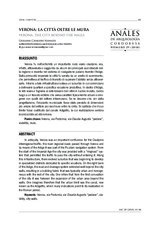Mostrar el registro sencillo del ítem
Verona: la città oltre le mura
| dc.contributor.author | Cavalieri Manasse, Giuliana | |
| dc.date.accessioned | 2019-02-01T07:44:55Z | |
| dc.date.available | 2019-02-01T07:44:55Z | |
| dc.date.issued | 2018 | |
| dc.identifier.issn | 1130-9741 | |
| dc.identifier.uri | http://hdl.handle.net/10396/17732 | |
| dc.description.abstract | Verona fu nell’antichità un importante nodo viario cisalpino: era, infatti, attraversata o raggiunta da alcuni dei principali assi stradali della regione e inserita nel sistema di navigazione padano tramite l’Adige. Dalla prima età imperiale la città fu servita da un anello di scorrimento, che permetteva al traffico di transito di superare l’abitato senza attraversarlo. Intorno a tale infrastruttura ruotava un suburbio in cui cominciano a delinearsi quartieri a specifica vocazione produttiva. In destra d’Adige, le reti viaria e fognaria si estendevano ben oltre il nucleo murato, dando luogo a un tessuto edilizio che aveva caratteri tipicamente urbani e omogenei con quelli del settore intramurano. Se ne desume che, sin dalla progettazione, l’impianto municipale fosse stato previsto di dimensioni più ampie del settore poi racchiuso entro la cinta. Si ipotizza che il suo limite fosse costituito dal canale Adigetto, la cui realizzazione sembra riconducibile ad età romana. | es_ES |
| dc.description.abstract | In antiquity, Verona was an important confluence for the Cisalpine interregional traffic: the main regional roads passed through Verona and by means of the Adige it was part of the Po plain navigation system. From the start of the Imperial Age the city was provided with a “ringroad” system that permitted the traffic to pass the city without entering it. Along this infrastructure, there evolved suburbia that was beginning to develop in specialized districts dedicated to specific vocations. On the right bank of the Adige, the road and drainage system extended well beyond the city walls, resulting in a building fabric that was typically urban and homogeneous with the rest of the city. One infers that from the first conception of the city it was foreseen the expansion of the urban area beyond the walls. One imagines therefore that the urban limit was the canal, now known as the Adigetto, which many indications point to its realization in the Roman period. | es_ES |
| dc.format.mimetype | application/pdf | es_ES |
| dc.language.iso | ita | es_ES |
| dc.publisher | Universidad de Córdoba, Área de Arqueología | es_ES |
| dc.rights | https://creativecommons.org/licenses/by/3.0/ | es_ES |
| dc.source | Anales de Arqueología Cordobesa 29, 41-83 (2018) | es_ES |
| dc.subject | Verona | es_ES |
| dc.subject | Via Postumia | es_ES |
| dc.subject | Via Claudia Augusta “padana” | es_ES |
| dc.subject | Viabilità | es_ES |
| dc.subject | Mura | es_ES |
| dc.subject | Viability | es_ES |
| dc.subject | City walls | es_ES |
| dc.title | Verona: la città oltre le mura | es_ES |
| dc.title.alternative | Verona: the city beyond the walls | es_ES |
| dc.type | info:eu-repo/semantics/article | es_ES |
| dc.relation.publisherversion | https://www.uco.es/ucopress/ojs/index.php/anarcor/index | es_ES |
| dc.rights.accessRights | info:eu-repo/semantics/openAccess | es_ES |

